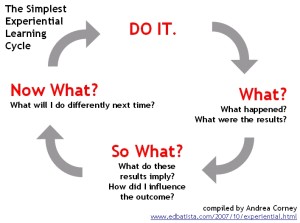Life’s lessons are all around us, if we are willing to look. When you choose to enroll in a 10 month long leadership program, as I have, life and leadership lessons hit you hard and fast. Sometimes it is hard to process and embed the learning. As I so often do, I’m going to process my thoughts of this experience on paper in the hope that it is meaningful for you as well.
When I think of learning, two images come to mind. The first is the classic classroom training: The teacher presents material, you read about it, you test out on it…Done! This type of learning was mostly in my past. The second type of learning that comes to mind is the kind that we are engaged in daily. These are the lessons we gain from experience. As I leave the third retreat in my leadership program I’m thinking about my own experiential learning in this way:
Linear Learning is Not Always Best. I was delighted to read in a 2014 USA Today interview with Benedict Carey, author of How We Learn, that science suggests that “the brain is not by nature a school learner. It’s a scavenging learner, a foraging learner. That’s the way it has essentially evolved to learn, by pieces, on the move, picking up information as it goes along.” Don’t you love this image of your brain moving through life looking for choice nuggets to provide what you need now? For me, it relieves my stress about not quite getting a concept or applying a skill perfectly when I am introduced to it. It suggests that what sometimes feels like failure is just my brain on its sometimes long and winding path to proficiency. What it also says is that using different methodologies to learn a new skill or concept is beneficial to integrating them.
Reflection Aids Learning. I often need time to process new learning. Whether it is a leadership concept I have just discovered in a book or a leadership behavior I have practiced in an experiential learning experience, taking time to think about how these lessons apply to me as a leader is an important integration step for me. I suppose this need for integration through reflection is why experiential learning is so popular. This simple model based on Kolb’s Theory of Experiential Learning is a good way to think through your own learning.
The first step is simply to do it. In spite of your conscious incompetence, practice this new learning, sweaty palms and all. Don’t just leave your learning to practicing, though. Take time to evaluate what happened. Notice what impact you made with your actions, either on your environment or on others. Ask yourself why it matters. Finally, consider what you will do differently.
Do It Even if It is Hard. Frankly, this is often the step I find most difficult. This is the process of integrating your new learning into your way of being. Leonardo da Vinci said “I have been impressed with the urgency of doing. Knowing is not enough; we must apply. Being willing is not enough; we must do.”
Frankly, this quote convicts me. Action is often where I get stuck. To gain this urgency of doing, keeping my ultimate purpose at the front of my mind is the most motivating thing I can do. What is your ultimate goal for the particular situation or, more broadly, for your life? How will integrating this lesson into your actions further your purpose? What if you don’t “do it?” How does inaction thwart your purpose?
Another practice I am building is to be accountable to someone else for my application of new learning. This is the beauty of being in a leadership program with 22 other people who have a vested interest in my ongoing growth. Even if you don’t have this built-in team of accountability partners, find the one or two people who care about your personal and professional development and ask them to hold you accountable. A professional coach can also challenge your commitment to your goals.
Learning is ongoing. It is essential to the fulfillment of our purpose. It is not always easy. As Nike says, “Just do it.”







1 Comment
Wow. Thanks for writing this. Confirms my thinking KTG!